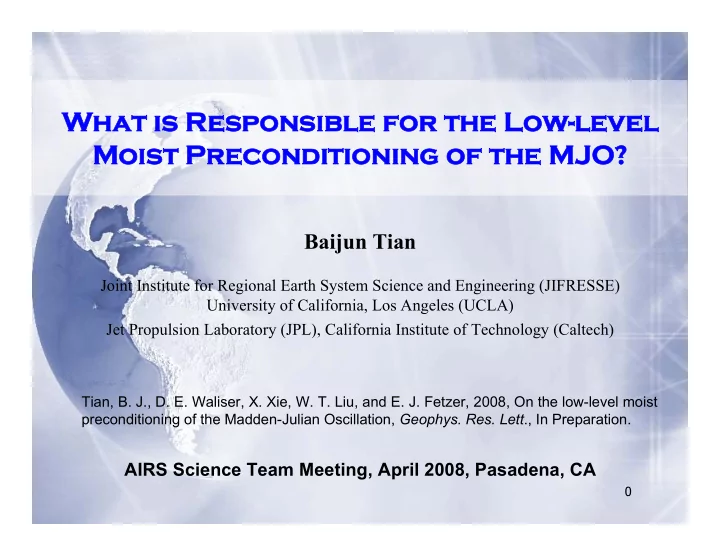

What is Responsible for the Low-level What is Responsible for the Low-level Moist Preconditioning of the MJO? Moist Preconditioning of the MJO? Baijun Tian Joint Institute for Regional Earth System Science and Engineering (JIFRESSE) University of California, Los Angeles (UCLA) Jet Propulsion Laboratory (JPL), California Institute of Technology (Caltech) Tian, B. J., D. E. Waliser, X. Xie, W. T. Liu, and E. J. Fetzer, 2008, On the low-level moist preconditioning of the Madden-Julian Oscillation, Geophys. Res. Lett ., In Preparation. AIRS Science Team Meeting, April 2008, Pasadena, CA 0
Madden-Julian Madden-Julian Oscillation Oscillation (a.k.a. Intraseasonal (a.k.a. Intraseasonal Oscillation) Oscillation) The MJO is characterized by slow eastward-propagating oscillations in tropical deep convection and large-scale circulation. It is the dominant form of intraseasonal variability in the Tropics. It impacts a wide range of phenomena (e.g., physical, biological and chemical components of the climate system). Our weather & climate models have a relatively poor representation. A comprehensive theory for the MJO is still lacking. Madden & Julian [1971; 1972], Lau and Waliser [2005], Zhang [2005] 1
Large-scale Zonal/Vertical Moist Structure Large-scale Zonal/Vertical Moist Structure -20 Days -10 Days Equatorial enhanced MJO convection as indicated by positive Low-level rainfall anomaly Moistening Leads 0 Days MJO Deep Convection. +10 Days +20 Days Tian, B. J., D. E. Waliser, Fetzer, Lambrigtsen, Yung, and Wang, 2006: Vertical moist thermodynamic 2 structure and spatial-temporal evolution of the MJO in AIRS observations. J. Atmos. Sci. , 63 , 2462-2485.
Question? What Physical or Dynamical Mechanism is Responsible for the Low-level Moist Preconditioning of the MJO? � W � t = E � P + MC 200 hPa Precipitation 500 hPa Moisture Convergence Evaporation Surface 3
Hydrological Data AIRS H2OVapMMR & TotH2OVap V4, L3, global, 1.0° x 1.0°, 2xdaily, 09/01/2002-04/30/2007. Chahine et al. (2006) TRMM 3B42 Rainfall: 40S-40N, 0.25° x 0.25°, 3-hourly, 01/01/1998-06/30/2007. Huffman et al. (2007) QuikSCAT & TMI Moisture Transport 40S-40N, 0.25° x 0.25°, 2xdaily, 08/1999-12/31/2005. Liu and Tang (2005) OAFlux Evaporation 65S-65N, 1.0° x 1.0°, daily, 01/01/1981-12/31/2002. Yu and Weller (2007) 4
General Analysis Methodology General Analysis Methodology (1) Perform an Extended EOF (EEOF) analysis on band-passed (30-90 day) rainfall data (e.g., TRMM). (2) Identify MJO events from EEOF amplitude time series. (3) Composite MJO events in band-passed rainfall and target quantities (e.g., moisture, evaporation and moisture convergence). Tian et al. [2006; 2007; 2008] 5
Spatial- Spatial- temporal temporal Pattern of Pattern of the 1 st st EEOF EEOF the 1 Mode of Mode of Rainfall Rainfall MJO MJO Anomaly Anomaly 6
Amplitude Time Series of the 1st EEOF of the 1st EEOF Amplitude Time Series Mode of Rainfall MJO Anomaly Mode of Rainfall MJO Anomaly The x indicates the dates (x) of selected MJO events. TRMM: 24 AIRS: 15 QuikSCAT&TMI: 14 OAFlux: 10 7
Composite MJO Cycle 8
Composite MJO Cycle 9
Composite MJO Cycle 10
Composite MJO Cycle 11
MJO Preconditioning Phase MJO Preconditioning Phase Large lower-troposphere moistening (W>0); Small precipitation anomaly (P~0); Enhanced moisture convergence (C>0); Suppressed evaporation (E<0); The The low-level low-level moist moist preconditioning preconditioning is is due due mainly mainly to to the the enhanced nhanced (low-level) (low-level) moisture convergence. moisture convergence. 12
Frictional Wave-CISK Schematic of the frictional wave-CISK model of the MJO (Wang 1998, 2005; Salby et al. 1994) 13
Wind-Evaporation Feedback Tropics - Mean Low-level Easterlies Ubar < 0 u’ < 0 to east of convection High wind speed => High Evaporation Favorable conditions for eastward propagation Low-Level Easterly Wind Anomalies = u’ < 0 Schematic of the wind-evaporation feedback model of the MJO (Emanuel 1987; Neelin et al. 1987) 14
Summary AIRS observation indicates that low-level moist anomaly leads the MJO deep convection and precipitation. QuikSCAT & TMI moisture transport and OAFlux evaporation observations indicate that the low-level moist preconditioning of the MJO is due mainly to the low-level moisture convergence instead of the surface evaporation. The satellite observations support the frictional wave-CISK theory instead of the wind-evaporation feedback theory of the MJO. 15
Precip & Low-level Moisture Anomalies Near-equatorial low-level moisture anomalies tend to lead rainfall anomalies 16
Precip & Moist Conv Anomalies Near-equatorial total column (low- level) moisture convergence anomalies 17 tend to lead rainfall anomalies
Precip & Evap Anomalies Near-equatorial surface evaporation anomalies tend to lag rainfall anomalies 18
Recommend
More recommend